
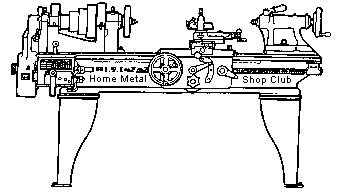
Volume 9, No 7 - July, 2004
 |
 Volume 9, No 7 - July, 2004 |
|
|
|
|
|
| President - |
Vice President - |
||
| Treasurer - |
Secretary - |
||
| Webmaster |
Editors - |
||
| Founder - |
SIG Coordinators - |
Statement of Purpose
Membership is open to all those interested in machining metal and tinkering with machines. The club provides a forum for the exchanging of ideas and information. This includes, to a large degree, education in the art of machine tools and practices. Our web site endeavors to bring into the public domain written information that the hobbyist can understand and use. This makes an organization such as this even more important.Coming July Presentation
Terry Ruppe is a factory rep for Centroid CNC (Computer Numerical Control). His presentation will include a short video of their CNC in operation as well as a hands on demo of the controller and the CAD/CAM software that runs it.Regular Meeting
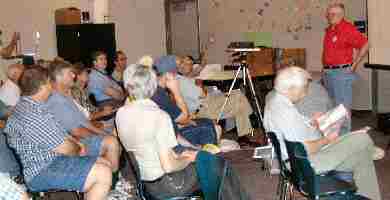 Election
of club officers was held:
Election
of club officers was held:
President - Chuck West, Vice President - Doug
Chartier, Treasurer - John Hoff, Secretary - Steven Clay, Webmasters
- Dick Kostelnicek and Doug Chartier, Librarian - Dennis Cranston, Newsletter
Editors - Dick Kostelnicek and Jan Rowland, CNC Sig Coordinator - Dennis
Cranston, Novice Sig Coordinator - Rich Pichler, and Casting Sig
Coordinator - looking for a volunteer.
Business Meeting
Minutes are sent via email or regular mail to club members.
Presentation
|
|
|
|
|
|
|
|
|
Dick Kostelnicek discussed the virtues and capabilities of a variety of metal work holding and support stands. His favorite is the Rigid flat top platform stand (top-right photo), as it doubles as a display holder for shop drawings.
Dick also showed the JRW sheet metal brake that he built after the design of Joe Williams – HMSC Member. Dick made a full set of drawings and bill of materials. The drawings have been debugged since the brake turned out just fine. A PDF containing the drawings, bill of materials, and photos of the machining processes is available at this link.
Field Trip
A group of about 15 club members visited the plant of Custom Rubber Products in Houston, TX. Doug Chartier organized the field trip and Custom Rubber's Steven Barile was our guide and host. We saw processes ranging from mixing, storing, testing and extruding rubber products used in the oil field industry. Their various products included wipers, seals and reamer cushions. Our thanks to Custom Rubber Products for a delightful and informative on site presentation.
Special Interest Groups Activity
Nothing to report this month
Show and Tell
|
Tony Burnett showed a black smith's hammer having unusual forging groves in its head |
Ray Ethridge related his trials and tribulation in building and employing square broaches to form the inside holes in transformed plastic coil bobbins. |
Ed Gladkowski showed the wear on a crucible he has used for some time in his metal casting furnace. |
Joe Williams brought a long offset oiler made of copper tube, a Ford fuel filter housing and with a peanut butter jar lid |
A letter from the Vice President
Fellow HMSC Members:
For those who did not attend the June meeting, we had elections. Chuck West, former Vice President, was elected to the office of President. That left the office of Vice President open. I was nominated and elected.
Chuck did a fine job in the role of V.P., and I will depend on his experience when I need assistance to continue the duties of the office. As the current Vice President, I would like to publicly and formerly thank our out going president, Tom Moore, for a job well done. As a regular club member, I also extend the same thanks. Thanks to Chuck West for his work in the position from which he has just been elevated. I am happy to assist Chuck in being as successful with his new position as he was in the previous.
The Vice President has a couple of fairly important duties. He reserves the meeting room from month to month and works out the presentation for each monthly meeting.
That leaves the program each month. Chuck put several together and still has a few in reserve. That's great, and I will depend on his input, but I would also like to hear from you. Here's an example of how you can help.
Last month Don Foster put on a very fine presentation of the various steam engines he has built over the years. Don is a club member, and many already know of his collection. But suppose Don was not a member, and no one in the club knew about him. Suppose further that he was your neighbor or someone you met at another function or perhaps you saw his display in a totally unrelated way when you went to his house to inspect the plumbing or fix one of his machines. Realizing the club might be interested in his display I hope would prompt you to contact me. I would try to work out a presentation for the club, and in Don's case, would also try to recruit him into the club.
So, what I am asking is in a way very little, but in another way quite a lot. I would like all club members to be continually on the lookout for people who might be considered for presentations at the monthly HMSC meeting. This is a lot because I am asking that you always have HMSC kind of in the back of your mind. It is asking a little because all I want is a name, maybe a contact phone number and a ten word or so description of who this person is. I will do the rest.
All of you are out and about from time to time. You may run into a machine salesman in a store where you buy drill bits. You determine he seems to be quite knowledgeable in his field. Talk to him. Tell him who you are and what your interest is. Get a name and number and send it to me. If it is an interesting subject, I will contact the salesman, and tell him up front, "Hey, you have a product that is interesting to our members. We would like to invite you to a club meeting where you can present your product and perhaps answer a few questions. We may not buy anything, but then again we might. In any case many in the club would be interested in technical information about your product."
Perhaps you are doing business with a commercial fabricator of some kind. That fabricator may be doing some type of machining in a creative way. That could be the basis for a club presentation. We took a field trip to Dorian Tools a few weeks ago. That field trip could have been a club presentation instead. The man who started the business and is it's CEO and owner today, has a great story to tell. He started the business as a one man machine shop and now ships all over the world. An ideal candidate for a presentation.
by Doug Chartier - HMSC Vice President
Featured Articles
The War on Error
by
Vance Burns - HMSC Member
Education is a wonderful thing, unless it comes as a surprise. If you've never had one, compare the measuring devices you typically use, one with another.
When in High School, so many years ago, I knew a shop teacher who kindly shared some of his recollections as a budding young machinist. In the infancy of the USA’s experiences with overseas manufacturing, his shop, enamored with the lure of cheap labor, sent a sizable project to the Orient, carefully spec’d and accompanied by voluminous detailed drawings. Whet with anticipation, the first shipments eventually began to arrive. The devices had been produced in record time and at considerable savings, and arrived carefully crated to the shop floor. My teacher related how everyone on the floor instinctually knew the importance of this occasion, and with mixed emotions, gathered about to witness a pivotal event in their company, perhaps their careers.
Carefully and with flare, the senior execs removed the packing, unable to quell their satisfaction in this triumph. Surely, within minutes, there before them was the realization of the conceptual drawings, exactly mirroring the prototype. What parts should move, moved flawlessly, and while a little rough in appearance, it was exactly as expected.
In an off-hand manor, management dismissed the crowd, and gave glib instructions to mount up the piece and put it through its paces. If management was happy, the shop was not. Production of these parts, while time consuming, was a certain part of their livelihood. No trace of Luddite-ism in their attitudes; they were reliving the insecurity that had vexed them since the outsourcing was announced.
With the majesty of one determined to rise above one’s condemnation, they carried the piece to the testbed, aligned the mating components and began to assemble the device in a professional manor. It was a massive piece, and seemed fixed on not aligning - its sheer bulk kept the men from manhandling it more. Riddled already with conflicting emotions, they were painfully aware that every eye in this busy shop was on them. Struggle as they may, it would not go. Fortunately, their supervisor, who had thus far maintained a degree of detachment, saw the mounting frustration and stepped in, quietly venting their despair.
When the new piece was examined, the careful eye noticed the bruising that occurred, and knew it meant miss alignment or possible dimensional error. Deciding that all involved should step back a bit, he called for the plans and his measuring devices. The furrowed brow of the super, and those hovering near him began to ease. Double, even triple checking left no doubt, the piece was off.
The news of this development turned the second floor somewhat chilly, and the air blue. Crimson blushed execs descended from Olympus, their harried drafts persons in tow, converging on the now suspect device. The inerrant judgment of those on the shop floor kept them at a safe, yet operable listening distance. Much perturbed, management declared the piece officially “off”. With no one at hand to properly absorb their invectives, their majesties ascended to make the phone calls. Fuel to the fire, the boxes just kept on coming…
While the distant manufacturing was put on hold, new projects followed to make part A and parts B fit. But all was not right in senior management, and decisions had to be made. Once more, detailed plans and drawings were produced, and this time, personally flown to the manufacturer - but with a twist. Precision micrometers and standards accompanied the drafts, with instructions on their importance.
Soon, redesigned parts flowed into the shop, and these parts worked and mated beautifully. The shop had no end of work, and the worker bees were more comfortable with their new arrangement. The management had a new respect for the history of their workforce, and the value of good communication.
Work Support Stand
by
Joe Williams - HMSC Member
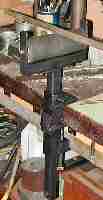 I
have the need to support long work in my bench vise and keeping it in place
is a problem that was solved with the fixture I built. It has a section of an
old printing press rubber roller, with ball bearings, for the top roll. I cut
off the section and made new ball bearing holders from brass stock. The support
column is a 1 x 1-in. section of square tube. The clamp is designed to
attach to the wood bench top. The support column slides in a similar section
of square tube, made from two sections of 1/8-in. steel angle welded together.
I had a simpler one made of a few sections of scrap angle but it was not easy
to move or adjust.
I
have the need to support long work in my bench vise and keeping it in place
is a problem that was solved with the fixture I built. It has a section of an
old printing press rubber roller, with ball bearings, for the top roll. I cut
off the section and made new ball bearing holders from brass stock. The support
column is a 1 x 1-in. section of square tube. The clamp is designed to
attach to the wood bench top. The support column slides in a similar section
of square tube, made from two sections of 1/8-in. steel angle welded together.
I had a simpler one made of a few sections of scrap angle but it was not easy
to move or adjust.
Using R8
Collets in a 4C Lathe Spindle
by Dick Kostelnicek - HMSC
Member
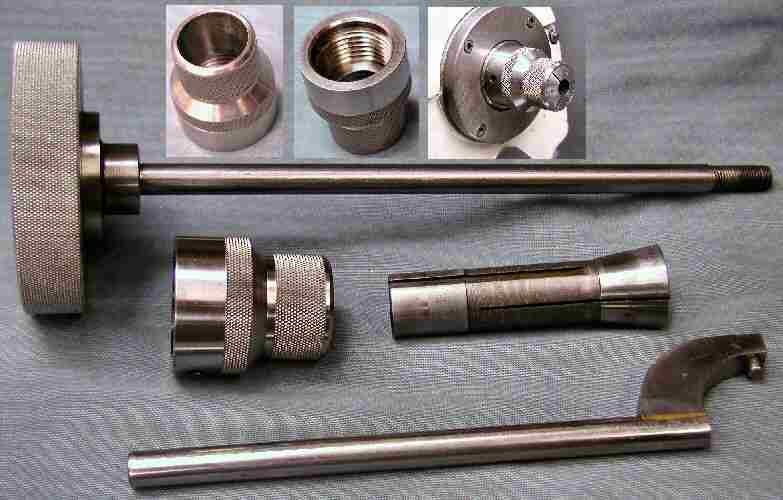
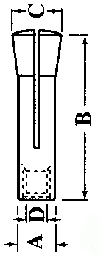
You can use the inexpensive R8 collets, commonly used in vertical milling machine spindles, in a lathe that accepts 4C collets. I built a R8 spindle nose adapter, pin spanner wrench, and draw bar for my 10-in. Rockwell lathe. The adapter screws onto the 1-1/2 in. spindle nose thread and has an 8 degree 25.5 min. taper (angle between the lathe axis and collet's sloping side).
First, make the nose adapter so it has a shoulder that fits snuggly on the unthreaded portion of the spindle nose (see the center picture in the top group of three). The threads inside the adapter can be sloppy so long as the shoulder seats well on the unthreaded portion of the spindle's nose. Turn the taper after the adapter is screwed in place and is well seated.
Fortunately, R8 and 4C collets have the same rear bearing diameter 0.950 in (A-dimension above drawing). They also have the same size keyway milled into their side. However, R8 collets won't allow you to pass long stock through their body, as is the case with 4C. You'll also need to make a draw bar with a 7/16-20 threaded rod (D-dimension above drawing) on one end and a handwheel on the other.
R8 collets are inexpensive and extremely accurate. With a spindle nose adapter, you'll be able to accurately hold short pieces of
round bar stock ranging from 1/16 to 7/8 in diameter in your lathe .
|
Visit Our Home Page at |
 |
Right click below then select [Save
Target As...]
From Netscape select [Save Link As..]
Microsoft
Word version of this newsletter 131 KB
